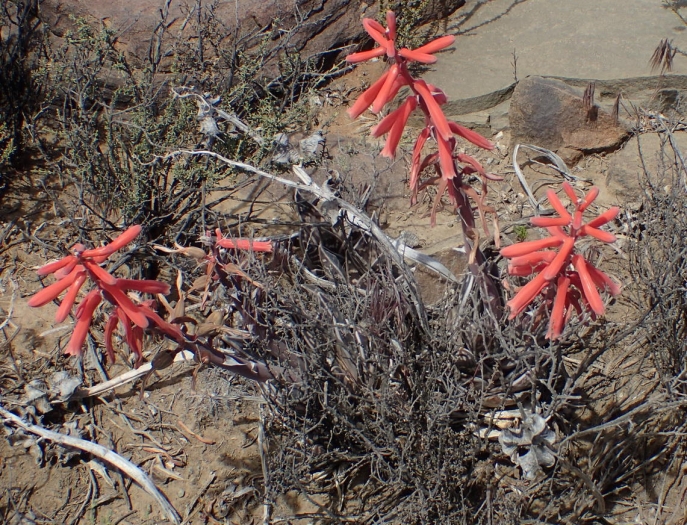Tiger Aloe
(Gonialoe variegata)
Tiger Aloe (Gonialoe variegata)
/
/

Nicola van Berkel
CC BY-SA 4.0
Image By:
Nicola van Berkel
Recorded By:
Copyright:
CC BY-SA 4.0
Copyright Notice:
Photo by: Nicola van Berkel | License Type: CC BY-SA 4.0 | License URL: http://creativecommons.org/licenses/by-sa/4.0/ | Rights Holder: Nicola van Berkel | Publisher: iNaturalist | Date Created: 42651 |

























Estimated Native Range
Summary
Gonialoe variegata, commonly known as Tiger Aloe, is a succulent plant native to the arid regions of South Africa and Namibia, specifically the Karoo desert. It is a slow-growing plant that reaches 8-12 inches in height, with a rosette of distinctive, triangular, variegated green leaves that have light green to white banding resembling tiger stripes. The leaves may also have a slight pinkish tinge when exposed to bright light. Tiger Aloe blooms in winter to early spring, producing tall spikes of tubular, orange-red flowers that are attractive to sunbirds and various insects, which serve as pollinators.
This plant is valued for its striking foliage and low maintenance requirements, making it a popular choice for rock gardens, succulent collections, and as a container plant. It is drought-tolerant, requiring minimal water once established, and thrives in rocky, well-drained soils. It prefers semi-shade to full sun conditions, but in hotter climates, it benefits from some afternoon shade to prevent leaf scorch. Tiger Aloe has received the Royal Horticultural Society’s Award of Garden Merit, indicating its exceptional performance in gardens. While generally pest-free, it can be susceptible to mealybugs and overwatering, which can lead to root rot. It is not considered invasive and is easily propagated by offsets.CC BY-SA 4.0
This plant is valued for its striking foliage and low maintenance requirements, making it a popular choice for rock gardens, succulent collections, and as a container plant. It is drought-tolerant, requiring minimal water once established, and thrives in rocky, well-drained soils. It prefers semi-shade to full sun conditions, but in hotter climates, it benefits from some afternoon shade to prevent leaf scorch. Tiger Aloe has received the Royal Horticultural Society’s Award of Garden Merit, indicating its exceptional performance in gardens. While generally pest-free, it can be susceptible to mealybugs and overwatering, which can lead to root rot. It is not considered invasive and is easily propagated by offsets.CC BY-SA 4.0
Plant Description
- Plant Type: Succulent
- Height: 1-2 feet
- Width: 1-2 feet
- Growth Rate: Slow
- Flower Color: Orange, Pink
- Flowering Season: Winter, Spring
- Leaf Retention: Evergreen
Growth Requirements
- Sun: Full Sun, Part Shade
- Water: Low
- Drainage: Medium, Fast
Common Uses
Drought Tolerant, Fire Resistant, Groundcover, Low Maintenance, Potted Plant, Rock Garden, Showy Flowers
Natural Habitat
Arid regions of South Africa and Namibia, specifically the Karoo desert
Other Names
Common Names: Tiger Aloe, Kanniedood Aloe, Partridge Aloe, Partridge Breast Aloe
Scientific Names: , Gonialoe variegata, Aloe ausana, Aloe punctata, Aloe variegata, Aloe variegata subsp. haworthii, Aloe variegata var. haworthii, Tulista variegata,
GBIF Accepted Name: